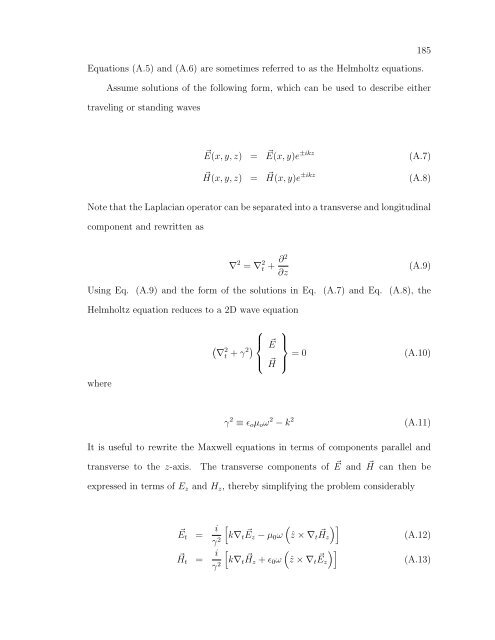STUDIES OF ENERGY RECOVERY LINACS AT ... - CASA
STUDIES OF ENERGY RECOVERY LINACS AT ... - CASA STUDIES OF ENERGY RECOVERY LINACS AT ... - CASA
Equations (A.5) and (A.6) are sometimes referred to as the Helmholtz equations. Assume solutions of the following form, which can be used to describe either traveling or standing waves E(x, y, z) = E(x, y)e ±ikz H(x, y, z) = H(x, y)e ±ikz 185 (A.7) (A.8) Note that the Laplacian operator can be separated into a transverse and longitudinal component and rewritten as ∇ 2 = ∇ 2 t + ∂2 ∂z (A.9) Using Eq. (A.9) and the form of the solutions in Eq. (A.7) and Eq. (A.8), the Helmholtz equation reduces to a 2D wave equation where 2 ∇t + γ 2 ⎧ ⎪⎨ ⎪⎩ γ 2 ≡ ɛoµoω 2 − k 2 ⎫ E ⎪⎬ = 0 (A.10) H ⎪⎭ (A.11) It is useful to rewrite the Maxwell equations in terms of components parallel and transverse to the z-axis. The transverse components of E and H can then be expressed in terms of Ez and Hz, thereby simplifying the problem considerably Et = i γ2 k∇t Ez − µ0ω ˆz × ∇t Hz Ht = i γ 2 k∇t Hz + ɛ0ω ˆz × ∇t Ez (A.12) (A.13)
FIG. A.1: A pillbox cavity exhibiting azimuthal symmetry. The resonator has a cross sectional radius R and a length d. Considering only TM modes, for which Hz = 0 everywhere, Eq. (A.12) and Eq. (A.13) reduce to Et = ik γ 2 ∇t Ez Ht = iɛ0ω γ 2 ˆz × ∇t Ez 186 (A.14) (A.15) Thus given the longitudinal electric field component, Ez, the remaining electric and magnetic field components can be derived. Up to this point, a cylindrical waveguide of arbitrary (but constant) cross section has been considered. An accelerating cavity is a resonator which is created by placing end plates at z = 0 and z = d as shown in Fig. A.1. Due to the reflections at the end plates, standing waves are created and the z-dependence can be described by
- Page 153 and 154: FIG. 5.18: A plot of the three valu
- Page 155 and 156: the beam’s response in regions wh
- Page 157 and 158: CHAPTER 6 BBU Suppression: Beam Opt
- Page 159 and 160: FIG. 6.1: Schematic of a FODO cell
- Page 161 and 162: plane [85]. Equations (6.7) and (6.
- Page 163 and 164: 6.2.3 Discussion The method of poin
- Page 165 and 166: FIG. 6.3: Beam envelopes (horizonta
- Page 167 and 168: FIG. 6.6: Beam position monitor rea
- Page 169 and 170: FIG. 6.8: A plot of 1/Qeff versus a
- Page 171 and 172: ⎛ ⎞ ⎜ ⎝ 0 0 0 0 0 −1/K 0
- Page 173 and 174: FIG. 6.11: A plot of 1/Qeff versus
- Page 175 and 176: FIG. 6.12: Threshold current for no
- Page 177 and 178: FIG. 6.14: Threshold current utiliz
- Page 179 and 180: TABLE 6.1: Summary of the measured
- Page 181 and 182: CHAPTER 7 BBU Suppression: Feedback
- Page 183 and 184: FIG. 7.1: A schematic of the feedba
- Page 185 and 186: FIG. 7.4: A coaxial 3-stub tuner us
- Page 187 and 188: All of these considerations are con
- Page 189 and 190: FIG. 7.6: Generic layout for a feed
- Page 191 and 192: in Section 4.2.1, however, in the p
- Page 193 and 194: FIG. 7.7: The threshold current as
- Page 195 and 196: FIG. 7.8: Threshold current versus
- Page 197 and 198: FIG. 7.10: The threshold current as
- Page 199 and 200: CHAPTER 8 Conclusions The work pres
- Page 201 and 202: le were experimentally measured. Du
- Page 203: APPENDIX A The Pillbox Cavity Start
- Page 207 and 208: Ez(ρ, φ) = ψ(ρ, φ) = E0Jm(γρ
- Page 209 and 210: FIG. B.1: Relationship of the S-par
- Page 211 and 212: FIG. C.1: Impedance and frequency o
- Page 213 and 214: FIG. C.5: Impedance and frequency o
- Page 215 and 216: BIBLIOGRAPHY [1] M. Tigner, Nuovo C
- Page 217 and 218: [22] L. Merminga, in Proceedings of
- Page 219 and 220: [50] C. Hernandez-Garcia et al., in
- Page 221 and 222: [79] L. Merminga et al., in Proceed
- Page 223 and 224: VITA Christopher D. Tennant Christo
Equations (A.5) and (A.6) are sometimes referred to as the Helmholtz equations.<br />
Assume solutions of the following form, which can be used to describe either<br />
traveling or standing waves<br />
E(x, y, z) = E(x, y)e ±ikz<br />
H(x, y, z) = H(x, y)e ±ikz<br />
185<br />
(A.7)<br />
(A.8)<br />
Note that the Laplacian operator can be separated into a transverse and longitudinal<br />
component and rewritten as<br />
∇ 2 = ∇ 2 t + ∂2<br />
∂z<br />
(A.9)<br />
Using Eq. (A.9) and the form of the solutions in Eq. (A.7) and Eq. (A.8), the<br />
Helmholtz equation reduces to a 2D wave equation<br />
where<br />
2<br />
∇t + γ 2<br />
⎧<br />
⎪⎨<br />
⎪⎩<br />
γ 2 ≡ ɛoµoω 2 − k 2<br />
⎫<br />
E<br />
⎪⎬<br />
= 0 (A.10)<br />
H<br />
⎪⎭<br />
(A.11)<br />
It is useful to rewrite the Maxwell equations in terms of components parallel and<br />
transverse to the z-axis. The transverse components of E and H can then be<br />
expressed in terms of Ez and Hz, thereby simplifying the problem considerably<br />
Et = i<br />
γ2 <br />
k∇t <br />
Ez − µ0ω ˆz × ∇t <br />
Hz<br />
Ht = i<br />
γ 2<br />
<br />
k∇t <br />
Hz + ɛ0ω ˆz × ∇t <br />
Ez<br />
(A.12)<br />
(A.13)



